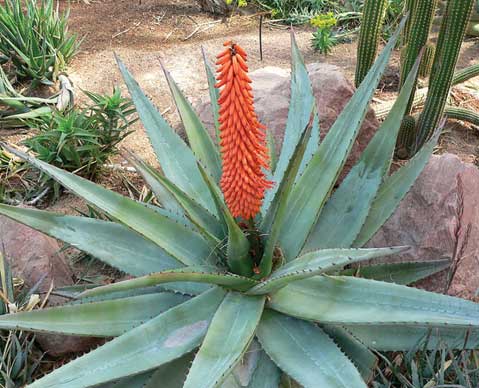Winter Wonders
The Many Shapes and Sizes of Aloe

Along Cabrillo Avenue and the bike path by the bird refuge, peeking from behind the gate at Lotusland on Sycamore Canyon Road, and cresting the bluffs by City College, the brilliant orange spikes of aloe blooms are lighting up the landscape. Many of those putting on the exuberant display are Aloe arborescens and a hybrid of A. ferox and A. wickensii often called Aloe salm-dyckiana, which branches prolifically, eventually forming dense clumps up to 5 feet or more in height. Median plantings of aloe vera (A. barbadensis) are also on display along Hollister Road and at the east entrance to UCSB’s campus. Although their flowers are a more subdued shade of yellow, they also brighten the commute on those traffic corridors.
Native to the dry habitats in Africa, aloes come in a staggering variety of shapes and sizes. The smallest rosettes hug the ground just a few inches tall and across, while their arborescent cousins can reach heights of 30 feet. Whatever their size, almost all aloes are armed with some spines. For the most part, these teeth occur just along the edges of the leaves and carry no great threat of bodily harm. They are generally brittle and break off if you happen to run into them, leaving only minor scratches. One of the most likable species, Aloe plicatilis, has such small teeth you probably won’t notice them on its flat, gray leaves. This plant looks for all the world like a sculpture composed of tongue depressors.
All aloes hail from warm to hot climates and in areas where native soils tend toward the dry side. Most are fairly forgiving of our heavy soils, but some are downright finicky, requiring excellent drainage to thrive. The most difficult of these (A. pillansii and A. ramosissima, for instance) are from areas that don’t experience the winter rainfall that is typical of our south coast. For all aloes, it is wise to site them on sloping or raised beds and incorporate sand into the soil for best root health. While they can withstand long periods without water, aloes will bloom and look their best with infrequent, but regular, irrigation.
Besides their inherent good looks, aloes are noted for a number of other beneficial attributes. Almost all of them contain some amount of the compound called aloin that gives them medicinal value. Aloe extracts have been used as a purgative to treat stomach complaints, but the most common use for the juice is to treat burns and other skin irritations.
Commercial sources of aloin are mainly produced from one species, the well-known aloe vera. Many cosmetic products, from skin creams to hair-care products, now contain aloe gel, the homogenized fleshy inner portion of the leaf. If you have an aloe vera plant or one of its fleshy relatives, like A. ferox, it is a simple matter to break off a leaf and apply the gel directly to the skin for instant first aid. Some people have mild allergic reactions to aloe products for ingestion, but very few are irritated by the topical use of the gel. As with any health product, caution when first using it is a good idea. So plant them for a ready supply of aloe medicine or because they provide a colorful winter display—or both.
February Tips
—Cut back fuchsias: In-ground plants can be cut back by half, and potted ones even more. Feed with a balanced organic fertilizer and stand back.
—Will the rains come again? The reservoirs may be full, but recent warm temps have begun drying out the garden. Monitor soil moisture and water as necessary.
—Plant greens for a quick harvest: arugula, beet greens, leaf lettuces, spinach, and cress are all ready to start picking in just 20-45 days.
—There is still time to plant: Bare-root fruit trees, roses, and other deciduous woody plants can all still be planted.
—Shop for winter-flowering shrubs such as camellia and azalea: Both benefit from soil very rich in organic material and mulched with more acidic materials like pine needles.
—Watch for snails and slugs: As temperatures begin to rise (spring does come early here), they will be hatching and munching.



